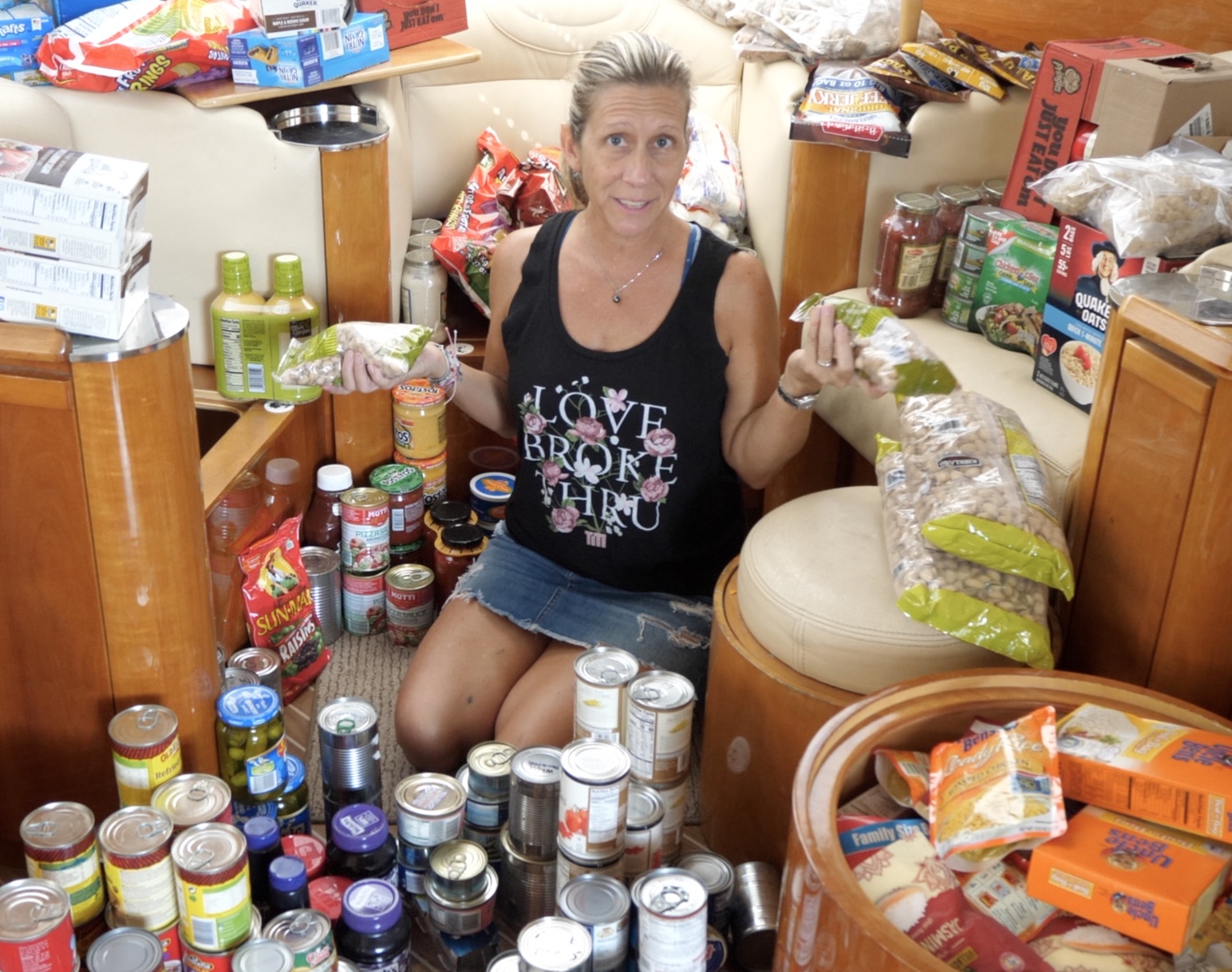Myth: If you don’t provision correctly, you will starve!
Jami S. sent me an email:
Our first trip is coming up in November as we sail to Guatemala with a group of 10 young adults. I was wondering if you would be able to shed some light on provisioning the boat and making grocery lists.
Thanks for your message Jami! Although provisioning is one of the most important aspects of living long-term on a sailboat, I’ve never known anyone who starved to death because they didn’t buy enough food. Quite the contrary: we’ve had to surrender stuff upon arrival in foreign ports.
At the time of writing this we are preparing to sail over a thousand miles—a 9-day nonstop journey—from Fiji to New Zealand. We have made half a dozen of these long passages and have learned from experience what is good to buy and what is not.
When meal planning, I try to gather meals that will be easy to throw together if I am seasick (yes, occasionally we still get seasick), and use very little gas or power to cook. Hamburger Helper and Chef Boyardee make some great boxed meals that enable you to provide a hot meal without slaving over the stove for an hour and using lots of your battery power. When at anchor or before a passage, I cook lots of noodles and brown lots of ground beef and freeze it, so that I can throw a hot meal together without spending too much time down below.
REPACKAGE ALL PAPER & CARDBOARD
Paper products and cardboard harbor teeny tiny eggs of little bugs that desperately want to infiltrate your boat. Before moving these items into your boat pantry, repackage them in vacuum sealed bags or Ziploc bags. You can reuse the Ziplocs, and the plastic prevents the little buggies from hopping from place to place in search of a warm environment in which to reproduce.
PASTA, RICE, PACKET SAUCES
Think NASA here: the drier and more compact, the better. Pasta and rice are both staples for easy to cook meals. Again, make sure to repackage them, as paper is a breeding ground for little bugs. Dry sauces in packets take up far less space than a jar of pesto or alfredo. You can find all sorts of rice and pasta and yummy sauces at grocery stores all over the world. We also like pre-boxed foods, like Hamburger Helpers and Kraft Macaroni & Cheese.
BREAD
If you are like me and don’t enjoy spending hours kneading and baking your own bread, don’t fret. Bread is an easy thing to find, from the Bahamas to the South Pacific. The problem for me, however, is that most of the time it isn’t sliced. If you want to make sandwiches, invest in a good bread knife or even better, and electric bread knife. I do own a bread machine, but it takes up lots of space and power (takes about 4 hours to make a loaf); I’d recommend either baking your own or buying lots and freezing it.
CANNED GOODS
Make sure to remove the paper labels from your cans and label them with a Sharpie. (Remember, bugs lay their eggs in paper and glue) Buy as much canned fruits, veggies, and meats as you can stow. Canned tuna, salmon, and chicken work great in many rice and pasta dishes. Although loaded with fat and preservatives, canned meals like Chef Boyardee Ravioli make quick and easy hot meals for long monotonous passages.
Don’t waste precious fridge space on refrigerated butter: canned butter is cheaper and stores easily. Obviously, you want to refrigerate once opened, but since we use so much butter for cooking and baking, we stocked up on canned butter. We’ve only used Anchor brand, but it is delicious and widely available.
FREEZE IT
Since you can freeze just about everything, you can never have too many freezers. Our regular fridge-freezer does not keep ice cream frozen, even though it is set at 3° F (-16°C). Therefore, since ice cream is such an important staple (not really), we have a portable DC powered Dometic freezer. Find it here. It’s nice to have a place to store plenty of meat on the rare occasion that you come across a port with really good-looking quality meats. And, if you’re catching a lot of fish you’ll need a place to keep it until you cook it.
You can freeze lunchmeat but don’t freeze sliced cheese (changes the texture); sliced cheese is pretty accessible worldwide, so when you come across a place with good cheese and fresh tomatoes, thaw out some bread and lunchmeat and make a sandwich. Shredded cheeses freeze well too (mozzarella, parmesan, etc) to be used in baking or on pizzas.
MILK
Did you know that humans are the only mammals that continue to drink milk after being weaned? Fresh milk is like gold to cruisers, and our family loves cereal and oatmeal with fresh Vitamin D cow’s milk. For long passages we stock up on boxed (UHT) milk, as it can keep up to a year without being refrigerated. It does have a slightly different flavor though, so give yourself a week of using it before you decide whether to keep with it or not. You might get used to it (like us and every other cruiser out there has had to). Boxed milk is available worldwide, except we did have a hard time finding a good supply of it in cattle-rich countries, like the US.
SNACKS
I’ve discovered that if we don’t have junk food like potato chips and candy on board, my kids will eat peanuts, cashews, and dried fruits. These snack items store well, and although pretty expensive in foreign ports, they are an excellent source of protein and fill a hungry tummy between meals. And since I am a master at hiding junk food, I will occasionally grab some sweet treats and stow them away to be enjoyed later, usually when we are just a couple of days away from landfall and we’ve eaten all the other snacks.
As we near New Zealand, we know that their import requirements prohibit many of the food items we have on board, so we are currently eating all we can, emptying freezers, and tossing anything that’s stale or past its expiration date. All countries are different, so make sure to check the rules at your next port of entry before doing a big provision run.
Check out our episode here where we provision for the 4,000nm Pacific Ocean crossing.
If I forgot to answer your question, please feel free to comment here or shoot me an email at renee@sailingzatara.com!
Happy Sailing,
Renee



